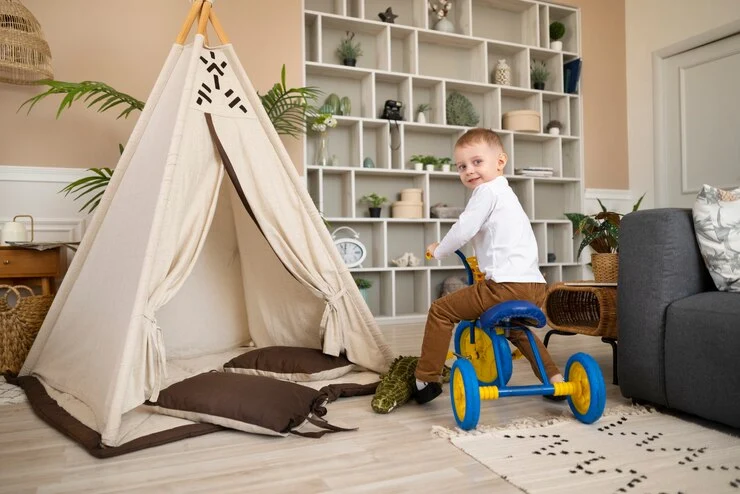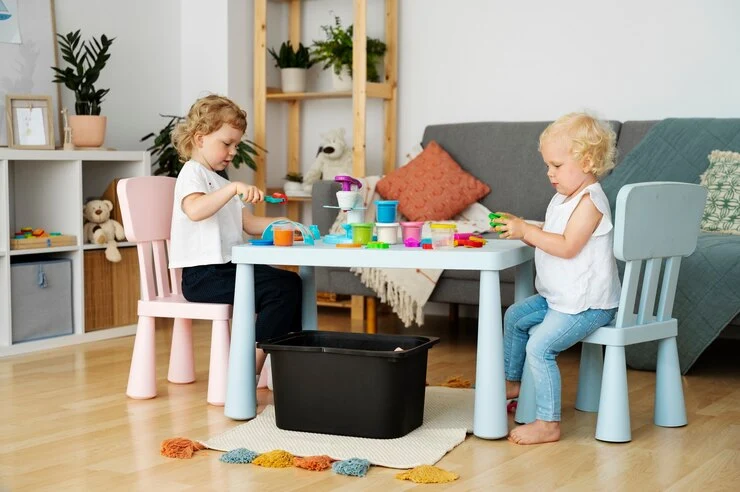Do you want to design a corner small play area in your living room? It can be both functional and stylish. Many families struggle to balance aesthetics with a child-friendly space. But with the right approach, it’s easy. This guide shares creative ideas and tips. You’ll learn how to create a cozy, organized, and stylish corner play area. It will blend perfectly into your living room.
Why Create a Play Area in Living Room?
The living room often serves as the central hub of a home, where family members gather to relax, entertain, and spend quality time together. By incorporating a small play area within this space, you can:
- Encourage family bonding by allowing kids to play nearby while adults relax or socialize.
- Save space by avoiding the need for a separate playroom.
- Monitor your children easily while they engage in creative and educational activities.
Key Considerations Before Designing Your Play Area
Before you start creating your small play area, it’s essential to evaluate your living room’s layout, your child’s needs, and your design preferences. Here are some factors to consider:
Assess Your Space
- Measure the available area to determine how much space you can allocate to the play zone.
- Identify corners or underutilized areas that can be transformed into a play nook.
Prioritize Safety
- Ensure that the play area is free from sharp edges, fragile items, and electrical outlets.
- Use non-toxic materials and child-friendly furniture.
Blend with Your Aesthetic
- Choose colors, furniture, and decor that complement your living room’s overall style.
- Opt for multipurpose items that serve both decorative and functional purposes.
Creative Ideas for a Small Play Area in Your Living Room
Corner Play Nook
Transform an unused corner into a delightful play nook. Add a soft rug, a small bookshelf, and a toy organizer. Use corner shelves to maximize vertical space for storing books, toys, and games.
Under-the-Stairs Play Area
If your living room has a staircase, consider utilizing the space underneath for a compact play zone. Install built-in storage or a mini desk to make the area both practical and inviting.
Foldable Play Zone
For families with limited space, a foldable play area can be a lifesaver. Use collapsible play mats for flexibility. Add portable storage bins for easy organization. Choose foldable furniture to save space. This creates a temporary play area. Store it easily when not needed.
Use a Play Tent
A small play tent or teepee can serve as a cozy retreat for your kids. Decorate it with string lights and soft cushions to create a magical hideaway.
Interactive Wall
Turn one wall of your living room into an interactive space. Install a chalkboard or magnetic board where kids can draw, write, or play with magnets. This keeps the play area contained and adds a playful touch to the room’s decor.
Toy Storage Bench
Incorporate a storage bench that doubles as seating. This not only provides ample space for toys but also blends seamlessly with your living room furniture.
Built-In Shelving
If you have the option, install built-in shelves in your living room to store toys, books, and art supplies. These shelves can be designed to match your existing decor, ensuring a cohesive look.
Use Rugs to Define the Space
A colorful or patterned rug can help define the play area in the living room. It also provides a soft surface for kids to sit and play on.
Compact Activity Table
Include a small activity table and chairs that fit the scale of your living room. This can serve as a space for drawing, puzzles, and crafts without taking up too much room.
Add Soft Lighting
Enhance the coziness of the play area with soft lighting. Consider using string lights, floor lamps, or wall-mounted sconces to create a warm and inviting atmosphere.

Tips for Keeping the Play Area Organized
Keeping a small play area tidy can be a challenge, but it’s not impossible with the right strategies:
- Use labeled bins: Label storage bins with words or pictures to make cleanup easier for kids.
- Rotate toys: Limit clutter by rotating toys periodically, keeping only a few out at a time.
- Involve your children: Teach your kids to tidy up after playtime as part of their routine.
- Choose multifunctional furniture: Opt for pieces like ottomans with hidden storage to keep toys out of sight.
Incorporating Educational Elements
A small play area can also be a learning space. Include educational toys, puzzles, books, and art supplies to stimulate your child’s creativity and cognitive development. You can also:
- Create a mini library with age-appropriate books.
- Add a world map or alphabet poster to the wall.
- Include sensory toys for hands-on learning experiences.
Common Mistakes to Avoid
When designing a play area in your living room, watch out for these common pitfalls:
- Overcrowding the space: Avoid filling the area with too many toys or furniture.
- Ignoring safety measures: Always prioritize childproofing the play zone.
- Clashing styles: Ensure that the play area harmonizes with the overall decor of your living room.
FAQs
How to make a play corner in a living room?
Choose an unused corner, add a soft rug, toy organizers, and child-friendly decor to create a dedicated play area.
How to set up a play area in a living room?
Designate a small space, use multifunctional furniture, and incorporate storage solutions to keep it organized and stylish.
What’s the best way to use an awkward corner in a living room?
Transform it into a play nook with a small table, shelves, or a cozy tent to make it both functional and attractive.
How to make a play area in a small house?
Utilize compact, foldable furniture and vertical storage to maximize space and keep the area tidy.
Where to put a playroom in a house?
If space is limited, integrate the playroom into a corner of the living room, an underutilized hallway, or even under the stairs.
Conclusion
Creating a corner small play area in your living room doesn’t mean losing style or functionality. With thoughtful planning, you can meet your child’s needs and keep your living room beautiful. Try a cozy corner nook, a foldable play zone, or a toy storage bench. Focus on balancing practicality and design. Use smart storage, add educational elements, and get creative.
Transform your living room today. Create a space that the whole family will enjoy!
